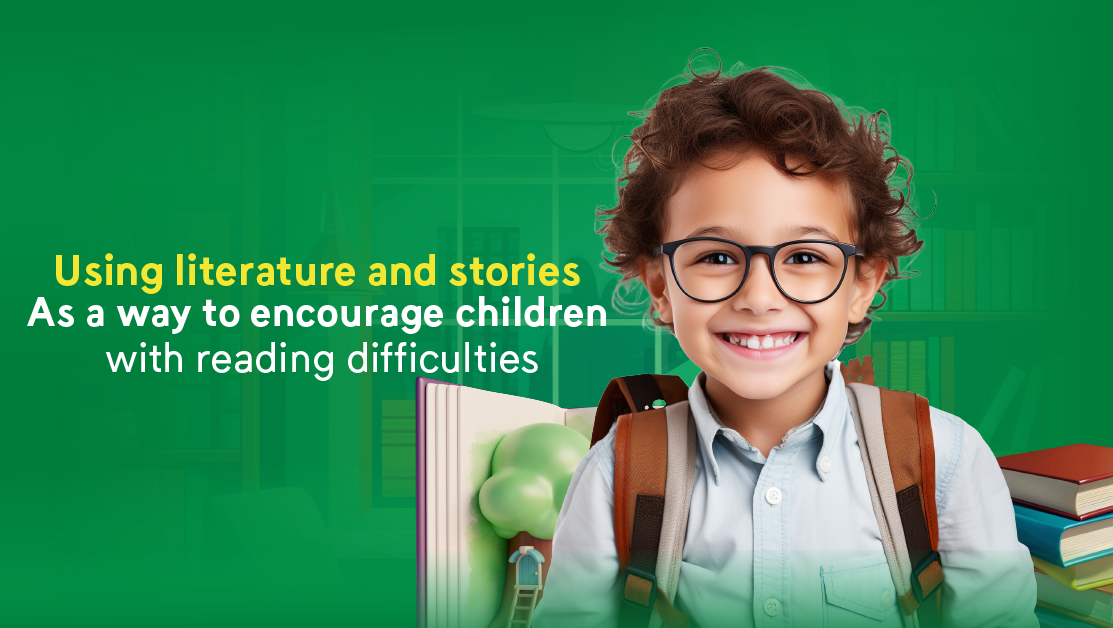
Reading is a fundamental skill that opens up worlds of knowledge, imagination, and communication. For many children, however, reading is not an easy task. Reading difficulties can stem from various causes, including dyslexia, attention deficits, and lack of early exposure to reading. Regardless of the cause, these difficulties can affect a child’s academic performance, self-esteem, and love for learning. One of the most effective ways to encourage children with reading difficulties is to use literature and stories. This approach not only builds reading skills but also fosters a lifelong love for books and storytelling. This article explores various strategies and benefits of using literature and stories to support people with reading difficulties.
Understanding Reading Difficulties in Children
Reading difficulties can manifest in various ways, posing significant challenges for children in their academic journey. These difficulties often fall into several categories, including decoding issues, comprehension problems, fluency challenges, and motivation deficits. So, in order to support people with reading difficulties, understanding these challenges can help in identifying and addressing them effectively.
Decoding Issues:
- Trouble understanding the relationship between letters and sounds.
- In the case of a first-grader child struggling with phonemic awareness, which is the ability to hear, identify, and manipulate individual sounds (phonemes) in spoken words. When his teacher asks the class to sound out the word cat, he has trouble blending the sounds /k/ /æ/ /t/ together to form the word. Instead, he might say c-a-t without understanding how the individual sounds combine to make a word. This difficulty of those reading difficulties makes it challenging for him to decode new words while reading, leading to frustration and slower progress compared to his peers.
- When it comes to a third-grader child diagnosed with dyslexia, which means that he often confuses letters that look similar, such as b and d, or letters that sound similar, like p and b. When reading, he might see the word dog and read it as bog, or see big and read it as dig. These decoding issues cause him to misread words frequently, making it difficult for him to understand the text and affecting his overall reading comprehension. This child’s decoding issues also mean that he reads at a much slower pace, which can lead to his avoiding reading tasks altogether.
Comprehension Problems:
- Difficulty in understanding and retaining what is read.
- With respect to a fifth-grader child who can read aloud with reasonable fluency, but struggles with grasping and understanding the main ideas of the texts he reads. After reading a short story, he is unable to summarize the plot or explain the central theme. He often focuses on minor details and misses the overarching narrative. When asked questions about the story, he might remember specific events or characters but cannot piece them together to form a coherent understanding of what the story was about. This issue makes it hard for him to participate in class discussions and complete assignments that require deeper comprehension.
- Concerning a seventh-grader child that has a case from reading difficulties which is trouble retaining information from texts. Even though he reads each paragraph carefully, by the time he finishes a page, he has forgotten much of what he just read. This lack of retention means that when he reaches the end of a chapter, he can recall very little of the content. During tests or class discussions, he finds it difficult to answer questions about texts he has read, as the information does not stay with him long enough to be useful. This problem affects his ability to study for exams and perform well in subjects that require strong reading comprehension, such as history and science.
Fluency Challenges:
- Reading is slow and laborious, affecting the overall understanding.
- In the instance of a fourth-grader child with reading difficulties of inconsistent speed and poor expression. Some sentences he rushes through, while others he reads painfully slowly, especially if they contain longer or unfamiliar words. His reading lacks natural rhythm and intonation, making it difficult for him to convey or grasp the nuances and emotional tone of the text. This inconsistency disrupts his ability to follow the narrative or understand the subtleties of characters’ dialogues and actions. As a result, this child often misses out on the deeper meaning and enjoyment of the stories, which affects his overall reading comprehension and interest in reading.
- As for a second-grader child who reads very slowly and with frequent pauses. Each word seems like a separate task for him, and he often needs to stop to sound out even common words. This slow, halting reading pace means that by the time he reaches the end of a sentence, he has often forgotten the beginning. Consequently, when reading a passage aloud in class, his lack of fluency makes it difficult for him to keep up with his peers and participate in group reading activities. His laborious reading process also leaves him little mental energy to engage with the content, hampering his comprehension.
Motivation Deficits:
- Lack of interest in reading due to repeated struggles and failures.
- Pertaining to an eighth-grader child has developed a strong aversion to reading. Due to repeated struggles with decoding and comprehension, he now associates reading with failure and frustration. Whenever it’s time for reading activities in class, he tries to avoid them by pretending to be sick, asking to go to the bathroom, or simply zoning out. At home, he resists homework that involves reading and prefers to play video games or watch TV. His lack of interest in reading is directly linked to his negative experiences, and this avoidance behavior further impedes his progress in developing essential reading skills.
- Regarding a sixth-grader child feels embarrassed about his reading difficulties, especially when compared to his classmates who read fluently. Over time, his repeated struggles have led to a belief that he is not good at reading and never will be. This low self-esteem causes him to be reluctant to participate in reading activities, both in and out of school. He avoids joining reading groups or participating in class discussions about books. Even when presented with books that match his interests, he shows little enthusiasm, as he anticipates the same feelings of inadequacy and failure. His motivation to read is severely hindered by his lack of confidence and past negative experiences.
Power of to Use Literature and Stories Strategies
Literature and stories have a unique power to engage and motivate children. They can transport readers to different worlds, introduce them to new ideas, and provide comfort and understanding. For children with reading difficulties, literature and stories can serve as both a tool for learning and a source of pleasure, for a way to support people with reading difficulties.
Motivation and Engagement:
- Interesting stories can capture a child’s attention and make reading a more enjoyable and less daunting task. When children are motivated by a compelling story, they are more likely to persist through challenges.
Repetition and Familiarity:
- Repetitive reading of favorite stories helps children recognize words and patterns, which can improve their reading fluency over time. Familiarity with the text reduces anxiety and builds confidence.
Interactive Read-Alouds:
- Use literature and stories while reading aloud to children in order to provide a model of fluent reading, as interactive read-alouds, where the reader engages the child with questions and discussions, can enhance comprehension and retention.
Building Vocabulary and Language Skills:
- Exposure to rich language in stories enhances vocabulary and comprehension skills. Through context and storytelling, children learn new words and phrases more naturally.
Social and Emotional Learning:
- Stories often contain themes and situations that children can relate to. This connection can help them understand their own experiences and emotions, fostering empathy and self-awareness.
Storytelling and Creative Writing:
- Encouraging children to create their own stories can boost their reading and writing skills. This activity taps into their imagination and allows them to practice language skills in a meaningful context, with the aim to support people with reading difficulties.
Choosing the Right Books:
- Selecting books that match a child’s reading level and interests is crucial. For struggling readers, high-interest, low-reading-level books are ideal. These books have engaging content that is accessible to readers with lower reading skills.
Visual Aids and Graphic Novels:
- Visual supports like pictures, charts, and graphic novels can aid comprehension and make reading more enjoyable. Graphic novels, in particular, combine visual and textual storytelling, which can be especially engaging for children who struggle with traditional text.
- Supposing a reluctant reader child found traditional books uninteresting and difficult, in that case his mother should introduce him to graphic novels, which combined his love for art with storytelling, as the visual elements will help him understand and enjoy the stories, eventually leading him to explore more text-heavy books.
Audiobooks and E-Books:
- Technology can be a great ally for children with reading difficulties. Audiobooks allow children to enjoy using literature and stories without the barriers of decoding text, while e-books with features like text highlighting and built-in dictionaries can support independent reading.
- If a child is struggling with reading comprehension and confidence, then his teacher ought to introduce him to audiobooks, which allows him to use literature and stories without the frustration of decoding. Over time, his listening skills will improve, and he will become more interested in reading along with the text. This dual approach will then help him to make significant progress in his reading abilities.
Reading Buddies and Peer Support:
- Pairing children with reading buddies or mentors can provide additional support and motivation. Peer support can make reading a social and enjoyable activity, reducing the stigma associated with reading difficulties.
- Assuming that Elementary schools implemented a reading buddy program where older students paired with younger ones to read together. This program not only will improve the reading skills of struggling readers but also will foster a sense of community and mentorship within the school.
Role of Parents and Teachers with a Child’s Difficulty
With supportive guidance from parents and teachers, the child’s reading journey will be fostered, leading to improved skills and a love for books, in order to support people with reading difficulties.
Consistent Practice and Patience:
- Regular reading practice is essential for improvement. Patience and positive reinforcement from teachers and parents can help build a child’s confidence and persistence.
- When parents and teachers understand the importance of consistent practice and patience in overcoming challenges related to reading difficulties, they will encourage children to read for at least 20 minutes every day, using books tailored to their reading level and interests, so, after a period of time the children’s consistent practice and the patient support of their parents and teacher pay off. Children will begin to feel more confident in their reading abilities and develop a love for books, as well as, with continued practice and encouragement, their reading skills improve, demonstrating how consistent practice and patience can empower children to overcome obstacles and thrive.
Create a Reading-Rich Environment:
- Surround children with books and reading materials that are accessible and appealing. Regular visits to the library and book fairs can also spark interest in reading.
- To create a reading-rich environment for children, the child’s room could be filled with colorful picture books and engaging storybooks, as well as, could be set up by a cozy reading corner with bean bags and soft pillows, with the objective of inviting the child to curl up with a book whenever he please. Additionally, the child needs to go to the local library every week, where he explores shelves filled with books on various topics and attend storytelling sessions. These regular visits to the library spark children’s interest in reading and foster a love for books from an early age.
Provide Individualized Support:
- Understanding each child’s unique challenges and strengths allows for tailored support. This might include one-on-one tutoring, specialized reading programs, or the use of assistive technologies.
- In particular, after recognizing that a certain child struggles with reading comprehension but excels in auditory learning, his teacher must provide individualized support to him by incorporating audiobooks and storytelling activities into his lessons. This tailored approach helps the child to better understand and engage with the material, leading to improved comprehension and confidence in his reading abilities.
Model Reading Behavior:
- Children often emulate the behaviors of adults around them. By showing a positive attitude towards reading and making time for it, parents and teachers can set a powerful example.
Celebrate Progress:
- Recognizing and celebrating small achievements in reading can boost a child’s confidence and motivation. Positive reinforcement is key to maintaining their interest and effort.
Encourage a Growth Mindset:
- Teaching children that reading skills can improve with effort and practice fosters resilience. Emphasizing progress over perfection helps them stay motivated despite difficulties.
To use literature and stories for the sake of encouraging children with reading difficulties is a powerful and multifaceted approach. By tapping into the inherent appeal of stories, educators and parents can motivate children, build their reading skills, and foster a lifelong love of books. The journey may be challenging, but with patience, creativity, and support, children with these difficulties in reading can overcome their obstacles and discover the joy of reading. The key is to create an environment where stories are accessible, engaging, and relevant, allowing every child to experience the magic of literature.















